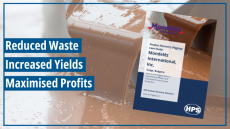Radio frequency heating could remove food pathogens
With more environmental regulations limiting the output of waste water and concerns about food safety, processors are on the look out for tools to help them reduce the use of abrasive chemical cleaners that could contaminate their products.
Allied Minds, which create partnerships with key universities based on early stage technology research, said that it is providing funding to newly formed firm, RF Biocidics, so that it can develop and commercialise its novel, cleantech approach to the disinfection and disinfestion of food such as fruit and vegetables.
Green technology "We believe the commercial opportunities for a green technological alternative to chemical pesticides is great and the market needs to be aware that such technology exists," Allied Minds COO Marc Eichenberger told FoodProductionDaily.com
The technology is characterized by its ability to differentially heat and eliminate undesirable pathogens (microbes, fungi) and arthropods (insects and mites), while minimizing the heating effect on the host material, claims Eichenberger.
According to RF Biocidics, traditional methods of disinfection and disinfestion of food utilise chemicals, heat or radiation.
These methods often have undesirable results such as toxins in the food chain and the environment or irreversible changes in the nutritional quality of the produce as well as negative consumer perception, said the company.
Lethal energy The company claims that using RF waves to deliver lethal energy to insects and microbes does not disturb or damage the host material or leave behind any residual compounds.
The process is called selective or differential RF heating, according to RF Biocidics, and is based on the difference in electrical conductivity between the pests (high) and the host commodity (low).
'
RF heating eliminates surface overheating, reducing thermal loads and allowing a food's quality and nutritional attributes to be maintained," said the company.
Eichenberg said that the technology has a variety of potential commercial applications and he expects it to be on the market within 12 to 18 months.
Cleaning guide Meanwhile, food factory cleaning and disinfection is the subject of new guidelines recently published by the Campden and Chorleywood Food Research Association (CCFRA).
CCFRA said its publication, 'Cleaning and disinfection of food factories: a practical guide', informs manufacturers on when to clean, how to clean and what chemicals to use in order to remove physical, chemical and microbiological contaminants.
"We were aware that are members needed information and good practice advice on cleaning and disinfection and realised there were no other comprehensive documents available to food manufacturers to provide this," the guide's author Karen Middleton told FoodProductionDaily.com
The document was written with the support of a Working Party including representatives from cleaning chemical manufacturers, hygiene service providers, retailers and food manufacturers, according to Middleton.
"The guidelines are targeted at all food processors worldwide, however any information on legislation will be specific to the UK/Europe and the disinfectant test methods discussed are the recognised European Norms (EN)," she added.














